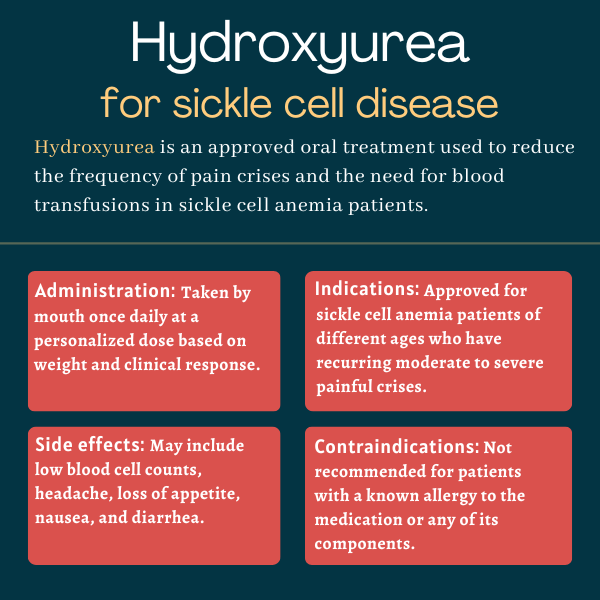Hydroxyurea for sickle cell disease
Last updated Aug. 7, 2024, by Marisa Wexler, MS

What is hydroxyurea for sickle cell disease?
Hydroxyurea is an oral medication that’s approved to reduce the frequency of painful crises and lessen the need for blood transfusions in people with sickle cell anemia, the most common and often the most severe form of sickle cell disease (SCD). Three brands of hydroxyurea are available in the U.S. for treating sickle cell, each with its own formulation:
- Droxia (oral capsules), formerly sold by Bristol-Myers Squibb and now by H2-Pharma
- Siklos (oral tablets), developed by Addmedica, which merged with CTRS to form Theravia, and sold in the U.S. by Medunik USA
- Xromi (oral solution), sold by Rare Disease Therapeutics.
A fourth brand of hydroxyurea, called Hydrea (also available as generics), is also approved to treat some types of cancer, but is not officially authorized in the U.S. for use in sickle cell patients.
Therapy snapshot
| Brand name: | Droxia, Siklos, and Xromi |
| Chemical name: | Hydroxyurea |
| Usage: | Used to reduce the frequency of painful crises and the need for blood transfusions in sickle cell patients |
| Administration: | Oral capsules, tablets, and solution |
How does hydroxyurea work?
SCD is a disorder that’s characterized by the production of an abnormal form of hemoglobin — the protein that red blood cells use to carry oxygen through the bloodstream — due to mutations in the HBB gene. That gene provides instructions for making a subunit of hemoglobin.
The abnormal protein tends to clump up inside red blood cells, deforming them into the sickle shape that gives the disease its name. This, in turn, interferes with the way red blood cells move through blood vessels, making them more prone to obstruct blood flow, and ultimately acting as the driver for painful crises and other SCD symptoms. People with sickle cell anemia, a subtype of SCD, have mutations in both copies of the HBB gene, leading to the production of a faulty version of hemoglobin called hemoglobin S.
Exactly how hydroxyurea works in sickle cell is not known. Evidence suggests that the therapy can increase levels of fetal hemoglobin, which is an alternative version of hemoglobin that is normally made in early fetal development, but stops being produced shortly after birth. By increasing the levels of fetal hemoglobin, which is more effective at transporting oxygen through the body than its adult counterpart, hydroxyurea may help counteract the effects of the mutated adult version of the protein. In patients, it works to reduce red blood cell sickling and destruction, lowering the frequency of painful crises, and the need for blood transfusions.
The therapy also may have other effects that can play a therapeutic role in sickle cell. These include increasing the amount of water in red blood cells and easing their deformability, as well as decreasing the number of neutrophils, a type of immune cell that interacts with sickled red blood cells to clog blood vessels, resulting in pain crises.
Who with sickle cell disease can take hydroxyurea?
Hydroxyurea was first approved by the U.S. Food and Drug Administration (FDA) in 1967 as a treatment for certain types of cancers. Its use has since been expanded to sickle cell disease.
All three hydroxyurea brands currently approved for sickle cell are indicated to reduce the frequency of painful crises and to lessen the need for blood transfusions in patients with sickle cell anemia, who have recurring moderate to severe painful crises.
- Droxia was approved by the FDA in 1998 for patients older than age 18.
- Siklos was originally approved by the FDA in December 2017, and is indicated for adults and children, ages 2 and older.
- Xromi was approved by the FDA in April 2024, and is indicated for infants and children ages 6 months to younger than 2 years.
Different brands and formulations of hydroxyurea also are available in other countries for the treatment of sickle cell, though specific indications may vary.
Who should not take hydroxyurea?
Hydroxyurea is contraindicated, or not recommended, for anyone with a known allergy to the medication or any component in the formulation.
The prescribing labels for Droxia, Siklos, and Xromi all come with a boxed warning noting that the medication may cause severe myelosuppression, or greatly reduce the bone marrow’s ability to produce new blood cells, as well as increase the risk of cancer.
How is hydroxyurea administered in sickle cell disease?
Each of the three brands of hydroxyurea available for treating sickle cell in the U.S. has its own formulation.
Droxia is supplied in the form of oral capsules that are available in three dosage strengths:
- 200 mg blue-green capsules imprinted with black ink “DROXIA” and “200”.
- 300 mg purple capsules imprinted with black ink “DROXIA” and “300”.
- 400 mg reddish-orange capsules, imprinted with black ink “DROXIA” and “400”.
Siklos is supplied in the form of oral tablets that are available in two dosage forms:
- 100 mg off-white functionally scored tablet to be divided in half and embossed with the letter “H” on one side.
- 1,000 mg off-white functionally scored tablet to be divided into quarters and embossed with the letter “T” on one side.
Xromi is supplied in the form of an oral strawberry-flavored solution that contains 100 mg/mL of hydroxyurea. The solution is clear colorless to pale yellow in color and is provided in a multiple-dose amber bottle.
In all formulations and brands, hydroxyurea is recommended to be taken by mouth once daily. The recommended starting dose for most patients is 15 milligrams per kilogram of body weight per day (mg/kg/day). For children taking Siklos, the recommended starting dose is slightly higher (20 mg/kg/day). Lower doses of hydroxyurea are recommended for patients with kidney function impairment across all brands and formulations.
The dose of hydroxyurea should then be adjusted based on blood tests assessing the degree of myelosuppression and the patient’s individual response to treatment. Blood cell counts should be monitored every two weeks following initial dosing and during dose adjustments. In general, the dose of hydroxyurea can be increased by 5 mg/kg/day every 8-12 weeks until a maximum tolerated dose or 35 mg/kg/day is reached, if blood cell counts are within an acceptable range; the dosage should not be increased if myelosuppression occurs.
If blood cell counts drop to the point of being in a toxic range, treatment should be discontinued until they recover. Following recovery, treatment can be resumed at a lower dose. In the case of Droxia and Siklos, the treatment should be permanently discontinued in patients whose blood cell counts reach a toxic threshold for a second time.

Hydroxyurea in sickle cell disease clinical trials
The approvals of the different brands and formulations of hydroxyurea were backed by several clinical trials assessing their efficacy and safety in sickle cell patients.
Droxia
Droxia’s approval in the U.S. was supported by a clinical trial dubbed the Multicenter Study of Hydroxyurea in Sickle Cell Anemia. The study enrolled 299 adults with moderate to severe sickle cell anemia who were experiencing at least three painful crises per year before entering the trial. In the study, participants were randomly assigned to take a placebo or Droxia. The original plan was to compare the effects of treatment after two years of follow-up; however, the study ended up closing early when interim data showed an obvious effect of treatment.
Available data showed that patients given Droxia experienced significantly fewer painful crises (median rate of 2.5 vs. 4.6 per year) and significantly fewer crises requiring hospitalization (median rate of 1 vs. 2.5 per year).
Droxia also outperformed the placebo in its ability to reduce the need for blood transfusions and in lowering the risk of acute chest syndrome — a sickle cell complication caused by blood vessel blockage in the lungs that can be life-threatening.
Siklos
The approval of Siklos in the U.S. was based mainly on data from a trial called the European Sickle Cell Disease Cohort study, or ESCORT HU (NCT02516579). The study enrolled about 1,900 people with SCD. Slightly more than half of the participants were adults, and the rest were children ages 2 through 17. All were treated with Siklos.
The results showed that, relative to rates seen in the year before starting treatment, Siklos significantly reduced the rates of painful crises lasting more than two days, by an average of about 40% in children and 50% in adults, in the first year of treatment. Rates of acute chest syndrome were reduced by 68% in children and by 57% in adults. Siklos also reduced the rates of hospitalizations by more than 40% in both age groups, and it reduced the number of patients requiring blood transfusions by roughly half.
Analyses from a subgroup of 141 children and 370 adults who had not been treated with hydroxyurea prior to enrollment also showed that one year of treatment with Siklos reduced the proportion of patients experiencing at least one painful crisis, one episode of acute chest syndrome, one hospitalization, or requiring a blood transfusion.
Xromi
Xromi’s effectiveness for the treatment of young children with sickle cell was established based on data from the use of hydroxyurea capsules in adult patients, as well as on safety and pharmacological data from an open-label study called HUPK (NCT03763656), which tested this formulation in children with sickle cell anemia as young as 6 months. Data from HUPK showed that Xromi had an acceptable safety profile and that the pharmacological profile of hydroxyurea in infants is similar to that of older children and adults.
Common side effects of hydroxyurea
With all forms of hydroxyurea, the most common side effects are low blood cell counts. Other side effects of hydroxyurea may include:
- infections
- headache
- dry skin
- loss of appetite
- digestive problems, such as nausea and/or diarrhea
- fever or flu-like symptoms
- hair loss.
Myelosuppression
All forms of hydroxyurea carry a boxed warning noting that the medication can cause severe myelosuppression, or greatly impair the function of the bone marrow, which is responsible for producing new blood cells. Blood cell counts should be monitored routinely in patients receiving treatment, as well as assessed before starting the medication. If necessary, the dose of hydroxyurea may be lowered or the treatment may be interrupted altogether. Treatment with hydroxyurea should not be initiated in people with reduced bone marrow function.
Cancer
The boxed warning also notes that hydroxyurea is carcinogenic, meaning that it can trigger mutations in cells that may lead to the onset of cancer. Skin cancer and secondary leukemia, a type of blood cancer, have been reported in patients receiving long-term treatment with hydroxyurea. Patients taking hydroxyurea should therefore be routinely monitored for signs of cancer, and should be advised to take steps to lower their risk of developing any of its types, such as using a strong sunscreen.
Fetal toxicity
Hydroxyurea can be toxic to a developing fetus if taken during pregnancy. Pregnant women should, therefore, be informed of the potential risks to the fetus.
Additionally, female patients with the potential to become pregnant should use an effective form of contraception while taking hydroxyurea and for at least six months after stopping treatment. A pregnancy test should also be taken prior to the start of treatment. Male patients of reproductive age should also use an effective form of contraception during treatment with hydroxyurea and for at least six months after stopping the medication.
Use with other therapies and vaccines
Hydroxyurea should not be used along with certain antiretroviral therapies (medications used to treat HIV), as this can cause damage to nerves, the liver, and/or the pancreas.
Using these medications also may increase the risk of adverse reactions to vaccines that contain a live virus, as well as lead to severe infections. Generally, live virus vaccines should be avoided in patients taking hydroxyurea. Patients on the therapy also may have a less potent response to other vaccines, and specialist consultation may be recommended.
Macrocytosis
Hydroxyurea can cause macrocytosis, where red blood cells are bigger than normal. This is typically harmless and goes away with time, but it can resemble the signs of another condition called pernicious anemia and mask its diagnosis. Preventive treatment with folic acid is recommended in patients taking hydroxyurea to reduce the chances of macrocytosis.
Abnormal laboratory tests
Hydroxyurea can cause results of blood sugar tests, as well as of tests used to measure the levels of uric acid, urea, or lactic acid to be falsely elevated. Providers and patients should be aware of the possibility of unreliable results with these tests in the presence of hydroxyurea.
Additional risks in people with bone marrow disorders
Skin problems related to poor blood flow, such as ulcers and gangrene, have occurred in people with myeloproliferative disorders — conditions in which the bone marrow produces an excessive number of blood cells — taking hydroxyurea. The therapy should not be started in patients who have leg sores; if ulcers develop, the dose should be reduced or treatment should be discontinued.
Some people taking hydroxyurea for bone marrow disorders have developed hemolytic anemia, a condition in which blood cells are destroyed. If this occurs in the absence of other potential causes, the treatment should be discontinued.
Use in pregnancy and breastfeeding
Although there is limited data on the use of hydroxyurea in pregnant women, animal studies have shown that the therapy’s administration during pregnancy can lead to fetal malformations and developmental delays in offspring. Due to the potentially harmful effects of the therapy on the developing fetus, patients on hydroxyurea should be aware of the risks and be carefully monitored in the event of a pregnancy.
Hydroxyurea can pass into breast milk. Due to the potential of serious adverse reactions, including cancer, for breastfed infants, it’s recommended that women abstain from breastfeeding while being treated with hydroxyurea.
Animal and human studies also indicate that hydroxyurea can compromise male fertility. For that reason, it’s recommended that male patients be made aware of the possibility of considering sperm conservation before starting treatment with hydroxyurea.
Sickle Cell Disease News is strictly a news and information website about the disease. It does not provide medical advice, diagnosis, or treatment. This content is not intended to be a substitute for professional medical advice, diagnosis, or treatment. Always seek the advice of your physician or other qualified health provider with any questions you may have regarding a medical condition. Never disregard professional medical advice or delay in seeking it because of something you have read on this website.
Recent Posts
- What I’ve learned about life, love, and sacrifice due to caregiving
- ED pain scores may predict future hospitalization for SCD children
- What to consider before making a change to your treatment regimen
- Buprenorphine may reduce opioid use for sickle cell disease patients
- Reflecting on 4 years of sharing my experiences with sickle cell
- Level of physical activity tied to less pain, blood viscosity in SCD: Study
- Celebrating ourselves is a way to promote sickle cell awareness
- BEAM-101 shows sustained benefits as treatment for sickle cell
- Attending a hematology conference as a sickle cell patient is empowering
- World Sickle Cell Day events include walks, vigils, building lights
Related articles






